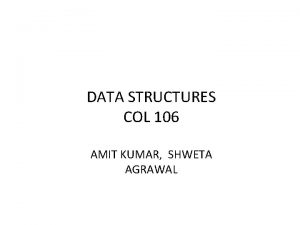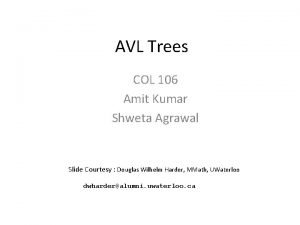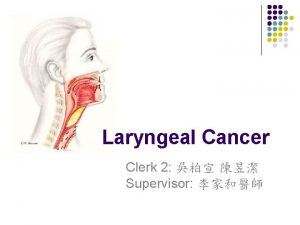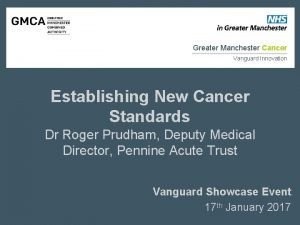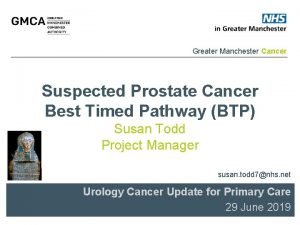Greater Manchester Cancer Diagnosis Staging Amit Kumar Kat




















- Slides: 20

Greater Manchester Cancer Diagnosis & Staging Amit Kumar / Kat Boros NWOOC

Diagnosis & Staging • Suspected soft tissue sarcoma on clinical assessment and imaging • Require histopathological diagnosis – grade / cellular analysis • Staging – disease extent

Principles of Biopsy • Treatment centre • Core biospy • Incisional or excisional; image guided • Don’t contaminate adjacent compartments; stick to involved compartment • In line with longitudinal incision • Haemostasis • Do not overly expose adjacent structures ie NV • Drains – in line with skin incision


Staging • Combines grade and histopath diagnosis • 1 – low grade, small, not spread • 2 – any grade, larger, not spread • 3 – high grade, not spread • 4 – any grade , spread

What next?

Histopathological assessment of soft tissue sarcomas

Key questions from the clinical point of view: What is the diagnosis? (diagnostic biopsies) and/or Is excision complete/adequate? (resection specimens) When will the result be ready?

The path of a specimen in the histopathology laboratory Specimen reception – • labeling, • sorting (subspecialty, BMS/consultant, high risk, urgent), • booking in same day/ next morning usually overnight fixation before cut-up, sometimes 48 hours (large specimens, high risk)

The path of a specimen in the histopathology laboratory Dissection – • “opening” • photos • macroscopic description • sampling calcified/bone samples – decalcification before processing

The path of a specimen in the histopathology laboratory • Processing - overnight • Embedding, cutting staining – next day(s) • Reporting – often further work including further stains, molecular tests

Reporting of soft tissue specimens Standards – RCPath guidelines/datasets ‘Layers of information’ – H&E stained slides - adequacy, cell/tissue types, benign/malignant features Immunohistochemistry – confirmation/further information on cell differentiation, proliferation index Special stains – matrix elements, infective organisms Molecular studies – FISH, RT-PCR, WGS

Dataset for histopathological reporting of soft tissue sarcomas Author: Prof. Cyril Fisher, 16 Aug 2017

Clinical • Site Core data items • depth from surface Pathological • size of tumour • histological type and subtype • grade • tissue planes involved • relationship to margins • • • Adipocytic Fibroblastic/myofibroblastic Pericytic (perivascular) So-called fibrohistiocytic Smooth muscle Skeletal muscle Vascular Chondro-osseus Gastrointestinal stromal tumours Peripheral nerve sheath tumours Tumours of uncertain differentiation Undifferentiated/unclassified sarcoma • stage • cytogenetic and molecular genetic findings (for small round cell tumours)

Immunohistochemical staining H&E S 100

Clinical • Site Core data items • depth from surface Pathological • size of tumour • histological type and subtype • grade • tissue planes involved • relationship to margins • stage • cytogenetic and molecular genetic findings (for small round cell tumours)

Morphological features of tumours of different grades: Benign (leiomyoma) Low grade (grade 1) leiomyosarcoma High grade (grade 2 -3) leiomyosarcoma


An example of the use of molecular studies in the diagnosis of sarcomas: FISH for MDM 2 amplification in atypical lipomatous tumour/well differentiated liposarcoma Thway, Khin et al. “Fluorescence In Situ Hybridization for MDM 2 Amplification as a Routine Ancillary Diagnostic Tool for Suspected Well-Differentiated and Dedifferentiated Liposarcomas: Experience at a Tertiary Center. ” Sarcoma vol. 2015 (2015): 812089. doi: 10. 1155/2015/812089

Thank you
 Breast cancer staging chart
Breast cancer staging chart Col 106
Col 106 Col 106 amit kumar
Col 106 amit kumar Microsoft dua
Microsoft dua Col 106 amit kumar
Col 106 amit kumar Col 106 amit kumar
Col 106 amit kumar Manchester and differential manchester
Manchester and differential manchester Greater manchester ageing hub
Greater manchester ageing hub Gm health and social care partnership
Gm health and social care partnership Strategic planning workshop greater manchester
Strategic planning workshop greater manchester Greater manchester good employment charter
Greater manchester good employment charter Gulf university
Gulf university Ajcc breast cancer staging
Ajcc breast cancer staging Tnm stage lung cancer
Tnm stage lung cancer Prostate cancer staging
Prostate cancer staging Glottic cancer staging
Glottic cancer staging Sorboline
Sorboline Breast tnm staging
Breast tnm staging Nursing process is organizes in which sequence?
Nursing process is organizes in which sequence? Frozen section
Frozen section Testicular cancer nursing diagnosis
Testicular cancer nursing diagnosis

